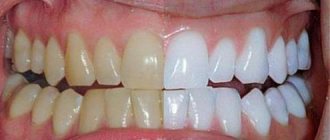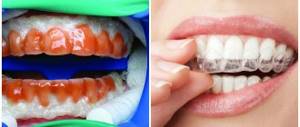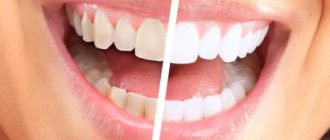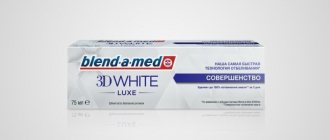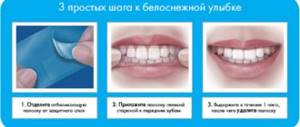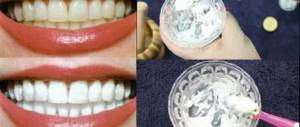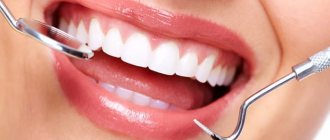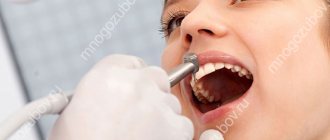Whitening with a “cold” or photodynamic laser Smartbleach 3LT is one of the most exclusive methods in modern aesthetic dentistry. It was developed by the Belgian company DEKA, which took into account and corrected the weaknesses of similar techniques. An alternative and effective method has been proposed - whitening with a special alkaline gel using a light wave in the green range of the spectrum.
What makes Smartbleach 3LT different?
A distinctive feature of Smartbleach 3LT is the non-acidic alkaline composition of the gel. An alkaline environment activates hydrogen peroxide, and in this system, the pigment will be discolored not by free oxygen, as in all traditional bleaching systems, but by singlet oxygen, whose perhydroxyl radicals are 50% more active than oxygen radicals in other systems. They perfectly penetrate dentin and lighten it without demineralizing or heating the enamel. The Smartbleach 3LT lamp further enhances the whitening effect as it emits green wavelengths between 510 nm and 535 nm with proven brightening power. All this makes it possible to repeat the procedure after a short period of time of several months, if the need arises.
Smartbleach 3LT has several more fundamental advantages:
- It is optimally suited for the management of patients with the most complex discoloration today – “tetracycline” teeth.
- The procedure is painless: due to the absence of heating the enamel, it is suitable for people with the most sensitive teeth and a low pain threshold.
- Lightening up to several shades according to the Vita Classic scale.
- This is the fastest clinical whitening procedure available - 3 x 9 minutes! And most importantly - without changing portions of the gel - just one application!
- Visible long-term results for years.
- Increased comfort for the patient – saliva ejectors built into the system.
- A nozzle with an arc-shaped lamp so that the incident light is evenly distributed over the teeth.
- Possibility of individual lamp settings for each patient.
Clinical whitening
This type of whitening is performed by a dentist in a clinic setting. The doctor first isolates your gums, lips, cheeks and tongue with special means, and then applies a whitening gel to your teeth and, if the technology requires it, turns on a lamp that activates the action of the gel.
Professional whitening sessions can take place in a series of 3-4 procedures for 9-15 minutes.
The ZOOM system assumes a single session from 1 hour to 2 hours, the SmartBleach system – up to 45 minutes.
Pros:
- quick result. You leave the clinic with a snow-white smile;
- there is no preparatory technical stage for the manufacture of mouth guards;
Cons (not always!):
- the effect of the gel is more intense;
- pain in the form of increased sensitivity is possible either during the procedure or for several hours after it. This occurs due to the rapid destruction of the pigment of the dyes and the exposure of microcracks in the enamel in which this pigment was located. To avoid unpleasant sensations after whitening procedures, the enamel microrelief is sealed with special fluorine-containing preparations and mandatory preparation is carried out for 2-3 days before whitening.
The best results are obtained from a clinical whitening system combined with home whitening 2 weeks after that.
Stages of the Smartbleach 3LT procedure
- Smartbleach whitening is performed on healthy teeth and gums after professional cleaning. Before starting the procedure, measurements are taken using the Vita scale and photographs are taken.
- Teeth to be whitened are isolated with a protective gel, which hardens on the gums under the influence of a photo lamp.
- The gel is applied ONCE to the teeth of the smile zone and activated by the green light descendant of the Smartbleach 3LT lamp.
- The teeth whitening reaction takes place within 27 minutes.
- After the procedure, the remaining gel is removed using a special vacuum cleaner, the gums are cleaned and the achieved result is measured.
If you follow the white diet recommended by doctors for at least two weeks after whitening, and take a mandatory fixing course of home whitening, your teeth will subsequently remain as white as possible.
Come for a consultation and sign up for Smartbleach 3LT Whitening available at Professor Akulovich's Teeth Whitening Center.
In-office whitening Philips ZOOM! WhiteSpeed 4th generation
A snow-white smile gives a person charm and self-confidence. Unfortunately, not everyone succeeds in maintaining white teeth, and often the reason does not lie in lifestyle. At the InWhite Medical clinic, patients are offered various methods of teeth whitening using the most modern technologies. One of them is safe and effective laser teeth whitening.
Causes of darkening of enamel
Under the tooth enamel there are hard dentin tissues - the shade of the teeth depends on their color.
The enamel itself has a translucent milky color and has good light transmittance, so the denser the top layer, the brighter a person’s smile seems to us.
Darkening of teeth is associated with discoloration of dentin and thinning of enamel, and the cause is not always due to smoking and poor oral hygiene. Teeth also darken due to the following factors:
- consuming large amounts of coloring products;
- mechanical dental injuries;
- genetic predisposition and heredity;
- taking medications containing fluoride;
- diseases of the oral cavity, such as caries.
Doctors at the InWhite Medical clinic not only perform whitening, but also make sure to find out the reason for the darkening of teeth - it is important for us to eliminate the problem, and not just mask visible imperfections.
In-office teeth whitening in dentistry InWhite Medical
In our clinic, laser whitening is performed using Smartbleach 3LT technology, developed by Belgian scientists.
The innovative system is considered the safest and most effective, since it is based on the use of hydrogen gel and a light beam similar to a laser in the green spectrum.
Conventional acid gels used in other whitening methods operate using an etching technique - they “knock out” impurities from tissues, thereby thinning the enamel itself, and aggressive laser radiation leads to the destruction of useful minerals - demineralization.
Thank you, your application has been accepted!
The alkaline hydrogen gel of the Smartbleach 3LT system is close in composition to saliva, therefore it is not an aggressive environment for teeth, and the green spectrum beam gently and without overheating destroys colored molecules in tooth tissues.
Even teeth with fluorosis and tetracycline staining (the appearance of whitish spots and dark stripes on the enamel due to taking medications containing fluoride and tetracycline) can be whitened using Smartbleach 3LT technology. In one procedure you can lighten your teeth by 7 shades, and the effect will last up to 5 years! Moreover, the price of laser teeth whitening is equal to a course of other types of procedures.
Stages of in-office whitening
The procedure takes only 30 minutes and consists of several stages.
- Consultation. During the examination, the doctor determines the degree and cause of darkening and necessarily identifies contraindications.
- Preparation. The lips and cheeks are isolated using a retractor, and a protective compound is applied to the gums to protect the patient from injury. The enamel is covered with a brightening gel.
- Bleaching. The device acts on each tooth for 1-2 minutes, after the procedure the enamel is coated with a mineralizing composition.
Myths about teeth whitening
Everything unknown - especially related to health - frightens patients, and information from the Internet does not always provide accurate answers to pressing questions. A therapist at InWhite Medical answered the most common ones.
Does whitening hurt?
In-office whitening is performed without anesthesia. Since the radiation is pulsed and short-term, it does not cause pain.
It is safe?
Of course, otherwise we would not offer this procedure to our patients! It has been scientifically proven that in-office whitening of the latest generation does not harm tooth tissue, does not dry out the enamel, does not remove useful minerals, and in addition, it thickens the enamel by 35%!
Can traditional whitening methods replace office lightening?
It's better to trust the professionals. Lemon juice, soda, foil, essential oils and activated carbon will not only not give visible results, but can also harm tooth tissue!
At what age can and cannot whiten teeth?
And can this be done during pregnancy? Whitening can be done from the age of 18, and the procedure is contraindicated for pregnant women - while carrying a child, teeth become more fragile and vulnerable. Bleaching is not recommended during this period.
What should I do if I have fillings and crowns?
Fillings and crowns, alas, cannot be whitened by any device; after the procedure, replacement of structures that match the shade of the teeth is required. In addition, the presence of fillings and crowns may be a contraindication to whitening, so a consultation is mandatory.
How much does in-office teeth whitening cost?
Don't risk your health - trust the professionals! Doctors at the InWhite Medical clinic will tell you in detail about the procedure, answer all your questions, including the cost of laser teeth whitening using the Smartbleach 3LT system, and use the most modern equipment to carry out safe and effective teeth whitening.
Prices for services
Service Cost
| Health lesson (plaque indication, personal hygiene training, selection of hygiene products) / A14.07.008 | For free |
| Primary appointment (examination, consultation) with a hygienist | 1 500 ₽ |
| In-office teeth whitening “Smart bleach 3 LT” (laser) / A16.07.050.001 | 45 000 ₽ |
| In-office whitening Philips ZOOM! WhiteSpeed (4th generation) / A16.07.050.002 | 22 000 ₽ |
Laser whitening: pros and cons
When talking about the pros and cons of laser teeth whitening, pay attention to the composition of the gel and the percentage of hydrogen peroxide in it. A high concentration of hydrogen peroxide, which itself is an acid, causes burns to the mucous membrane, damage to the enamel, dentin and dental pulp.
Painful sensations after bleaching are a consequence of improper manipulation. The use of low-quality equipment and consumables also leads to disastrous results.
The method of painless laser photodynamic BIO teeth whitening Smartbleach 3LT has earned many fans, both among dentists and patients. The technology carried out in the laser dentistry clinic is devoid of the above disadvantages.
Teeth whitening
Tooth enamel darkens for many reasons. This includes the consumption of products that contain coloring pigments, dental diseases, and smoking and alcohol abuse.
At the same time, a snow-white smile is one of the components of the image of a successful, attractive and self-confident person.
That is why the teeth whitening procedure is one of the most popular in dentistry today.
Dental specialists carry out professional whitening, using only the most effective and safe methods in their work.
Our clinic offers hygienic dental cleaning Air Flow and ultrasonic cleaning, as well as photodynamic whitening Smartbleach 3LT - the safest technology to date that has no analogues.
Indications
The indication for professional oral hygiene is the patient's upcoming dental treatment. Whitening with the Smartbleach 3LT system is carried out according to the patient’s personal desire to lighten the shade of tooth enamel.
Teeth whitening methods
The dentist chooses the whitening method depending on the indications.
Professional oral hygiene is not only an opportunity to lighten enamel, but also an integral part of preparation for any dental treatment.
- Ultrasonic cleaning. This method is used to remove hard plaque from teeth. Ultrasonic waves, tuned to a specific frequency and vibration amplitude, crumble and destroy dental plaque. The stone is separated from the enamel with a special scaler, which does not damage the enamel. During such cleaning, deposits are easily removed from hard-to-reach places - between the teeth and under the gums.
- The Air Flow system is a modern technique for removing soft plaque from the surface of teeth. During this procedure, a special device is used that delivers a strong stream of air with a mixture of water and sodium bicarbonate salts to the surface of the teeth. The result of this procedure is the removal of plaque and lightening of the enamel to its natural shade.
The described methods can return your teeth to their natural shade. If the natural color of the enamel is not snow-white enough, photodynamic bleaching can affect the structure of the dentin shade.
The Smartbleach 3LT technique involves using a special alkaline-based gel and a special lamp with a green emission spectrum. Despite the high power, this lamp is absolutely safe for teeth. The enamel does not heat up during the procedure, thereby eliminating the risk of tooth demineralization.
Using Smartbleach 3LT whitening, you can get rid of enamel stains of any shade (yellow, gray or brown). Oxygen radicals released from the gel particles under the influence of light freely penetrate the tooth structure, easily breaking down the pigment. In just 30 minutes you can achieve a long-lasting teeth whitening effect of several shades.
Bleaching Safety
Modern whitening systems are not only effective, but also safe. In the past, teeth whitening carried the risk of thinning and damaging tooth enamel.
Today, this procedure is more likely to be beneficial for the teeth than to pose any risk to the teeth.
There is one condition: whitening must be carried out by a qualified specialist in a certified medical center.
Preparation for the event
The Air Flow system and ultrasonic teeth cleaning do not require prior preparation from the patient, since they themselves are a preparatory stage for dental treatment.
Before photodynamic whitening, you will need to consult a dental hygienist - such whitening is carried out only after treatment of existing dental diseases.
Contraindications
Dentists do not recommend whitening for patients under 18 years of age. Whitening is also not performed on pregnant and breastfeeding women.
If you wear braces, whitening should be postponed until after they are removed. Wearing braces is not a contraindication for professional teeth cleaning. On the contrary, regular implementation of this procedure will help prevent the development of oral diseases during this period.
After teeth whitening
No matter what kind of whitening is performed, it is necessary to strictly follow the recommendations of the dentist to maintain the results of the procedure. The main rule is to try to minimize the consumption of coloring products and give up bad habits.
Doctor's advice
- Even in the complete absence of contraindications to teeth whitening, this procedure should not be repeated often - despite the safety of modern whitening systems, excessive use of them can be harmful to dental health.
- It is enough to carry out the Air Flow procedure once a year. If there is excessive plaque formation, this procedure can be done twice a year, but not more often.
- The rapid formation of plaque should be a reason to reconsider your habits.
- After brushing, use toothpaste for sensitive teeth.
Cost of teeth whitening
| Consultation with a dental hygienist | FOR FREE |
| Teeth whitening SmartBleach 3LT | 35 000 |
| Endodontic whitening (1 session) | 3 900 |
I want to whiten my teeth! What is important to know and which method to choose?
Together with dentists, we conduct an educational program on the topic of teeth whitening. What you need to know when planning whitening, can it be harmful, how long does the effect last and how to choose a method that is right for your teeth?
To diagnose the initial color of teeth, you can compare the color of the enamel with the color of the whites of the eyes. Ideally they should match. At the patient's request, we can achieve a lighter shade.
Will this look natural?
Certainly! In general, if you decide to undergo the procedure, you should not expect that your teeth will be dazzling white with a bluish tint. If you see such an unnatural color, then it is most likely just veneers. You won’t get a similar result with bleaching, even if you do it for days. Just destroy the enamel.
What are the contraindications to whitening?
Whitening is not suitable for those who already have ceramic or filling material restorations on their front teeth. Because the teeth will change color, but the restoration will not. You need to either be ready to change everything after whitening, or simply not do it. But tooth sensitivity is no longer a contraindication for whitening, because the most gentle methods have appeared.
If I whiten my teeth, will it last forever? How long does the effect last?
Repeated whitening courses can (and should!) be carried out. Sometimes once every six months. Because the effect is by no means eternal. Much depends on your diet after whitening. After all, almost all drinks and food stain the enamel: and not only coffee and tea, but also berries, fruits and vegetables (even carrots!), and juices. And teeth darken over time.
Teeth whitening - is there any harm?
There is a myth that enamel problems arise after whitening. Actually, this is not true. The whitening procedure does not affect the structure of the enamel, but only discolors the pigment. Caries will not begin to develop rapidly, I can confirm from my own experience. Dentists themselves would not whiten teeth if it was truly harmful.
What is important to remember when planning whitening?
Never go for whitening a couple of days before important events! It happens that a patient comes and says: “I have a wedding tomorrow, I urgently need to whiten my teeth.” Firstly, after some techniques, tooth sensitivity increases, and secondly, it is necessary to follow a white diet for at least ten days. It turns out that during the holiday even a glass of red wine will be prohibited.
Ekaterina Zubareva (Boston Institute of Aesthetic Medicine)
If you want maximum whitening results, then you should consider the Zoom in-office whitening method. The procedure takes about two hours. First, we apply a special Relief gel to the teeth to reduce their sensitivity.
After this, a whitening gel is used, which is activated by the radiation of a halogen lamp and thanks to this penetrates into the tooth tissue to the desired depth, brightening them. By the way, almost all office methods operate on this principle: you need a whitening gel and its activator.
There is one “but”: if the patient suffers from increased tooth sensitivity, then I recommend taking a closer look at other whitening methods.
You also need to prepare for the fact that during the procedure itself and for several days after it, unpleasant sensations may occur (precisely due to increased sensitivity).
Anna Volkova (Aesthetic Dental Club)
This is a very gentle whitening method. But the dazzling white result that patients often expect will most likely not be achieved the first time - and I always warn about this.
We chose the FONALaser laser system because we believe this method is the most harmless for the patient. And what’s more, even useful! The fact is that during the procedure, cracks in the enamel are sealed, it becomes stronger and denser.
And laser radiation, in principle, has a healing effect, therefore it has a beneficial effect on the tissues of the oral cavity. Laser whitening can be used even by those for whom other methods are contraindicated. For example, patients with high sensitivity, with wedge-shaped defects.
This is a cold whitening method: the diode laser does not heat or destroy the enamel. Very good results are obtained when the patient has previously performed other whitening techniques.
Tatiana Moreva (MEDI)
We offer three whitening options: photodynamic, laser and ZOOM. I name them in order: from the most gentle to the most effective. So, photodynamic bio-whitening Smartbleach 3LT is suitable for those patients who initially have a fairly light enamel color or high tooth sensitivity.
This is also an excellent option for those who have previously undergone clinical or at-home whitening and want to maintain or improve their results. A huge plus is that tooth sensitivity practically does not increase - neither during the procedure nor after it.
It all takes less than thirty minutes: we apply a whitening gel with a low concentration of hydrogen peroxide, and then activate the composition with a 3LT green laser. The gel, under the influence of a laser, changes the pH value from neutral to alkaline. What is very important: the alkaline environment is not aggressive for the enamel and the possibility of its demineralization due to the procedure is excluded.
The technique is popular, because there are patients with high tooth sensitivity. For them, the main thing is to avoid discomfort during whitening. They are willing to use Smartbleach 3LT repeatedly to gradually build up the effect.
As an alternative, patients can always purchase home whitening systems from the clinic.
This (unlike the strips and sets from supermarkets popular on Instagram) is also a professional method! To conduct a course of home whitening, first, impressions of the patient’s teeth are taken, from which individual trays with a reservoir for the whitening gel are made in the laboratory. The patient is instructed and begins to wear these aligners at home. The wearing time may vary - for example, half an hour in the morning and half an hour in the evening for ten days.
The home systems provided by clinics are effective and safe. The patient is in contact with the doctor, the entire process is controlled. As for non-professional sets, this is not very effective.
And it’s dangerous if you don’t follow the instructions, don’t evaluate contraindications, and do it uncontrollably. Complications from self-whitening are possible: the same hypersensitivity and discomfort in the gums.
Service cost
* Prices are shown without discount
ServicePrice, rub.
| Laser whitening SmartBleach 3lt | 35000 |
Shalimova Natalia
Chief physician, dentist-therapist
Candidate of Medical Sciences.
Trained at the Canadian Academy of Aesthetic Dentistry.
Member of ICCMO (International College of Cranio-Mandibular Orthopedics).
Shalimov Evgeniy
Dentist-orthopedist, periodontist
Trained at the Canadian Academy of Aesthetic Dentistry.
He completed his specialization at the University of Turin, Italy.
SPECIFICATIONS
| Light source | 3 high power light sources similar to laser light |
| Wavelength | 532 nm ± 5 nm |
| Power | Max. 250 mW/cm² / adjustable |
| Area of influence | 17 cm2 |
| The number of cycles | Until 3 |
| Cycle duration | 9 minutes / adjustable |
| Classification | I protection class |
| Cooling | Internal |
| Environmental conditions | Temperature: +15°C to +30°C, humidity ≤85% (non-condensing) |
| Storage and transportation conditions | Temperature: 0°C to +50°C, humidity ≤85% (non-condensing) |
| Dimensions | 10×35×30 cm (W×D×H), 3.5 kg |
| Accessories | Bite block and attachment |
| Power supply | 220 V / 50 Hz / 2 A (max.) |
Are there any contraindications?
There are few contraindications for teeth whitening, and they are reported during the initial examination. Typically this is:
- age under 16 years
- multiple caries on bleached surfaces
- some common diseases
- the presence of fillings and crowns on teeth in the smile line - if they are not expected to be replaced
- diseases of the oral mucosa in the acute stage
- increased tooth sensitivity - special preparation required
- taking certain medications

